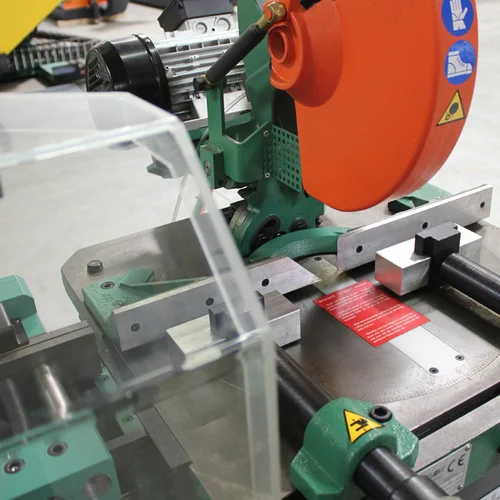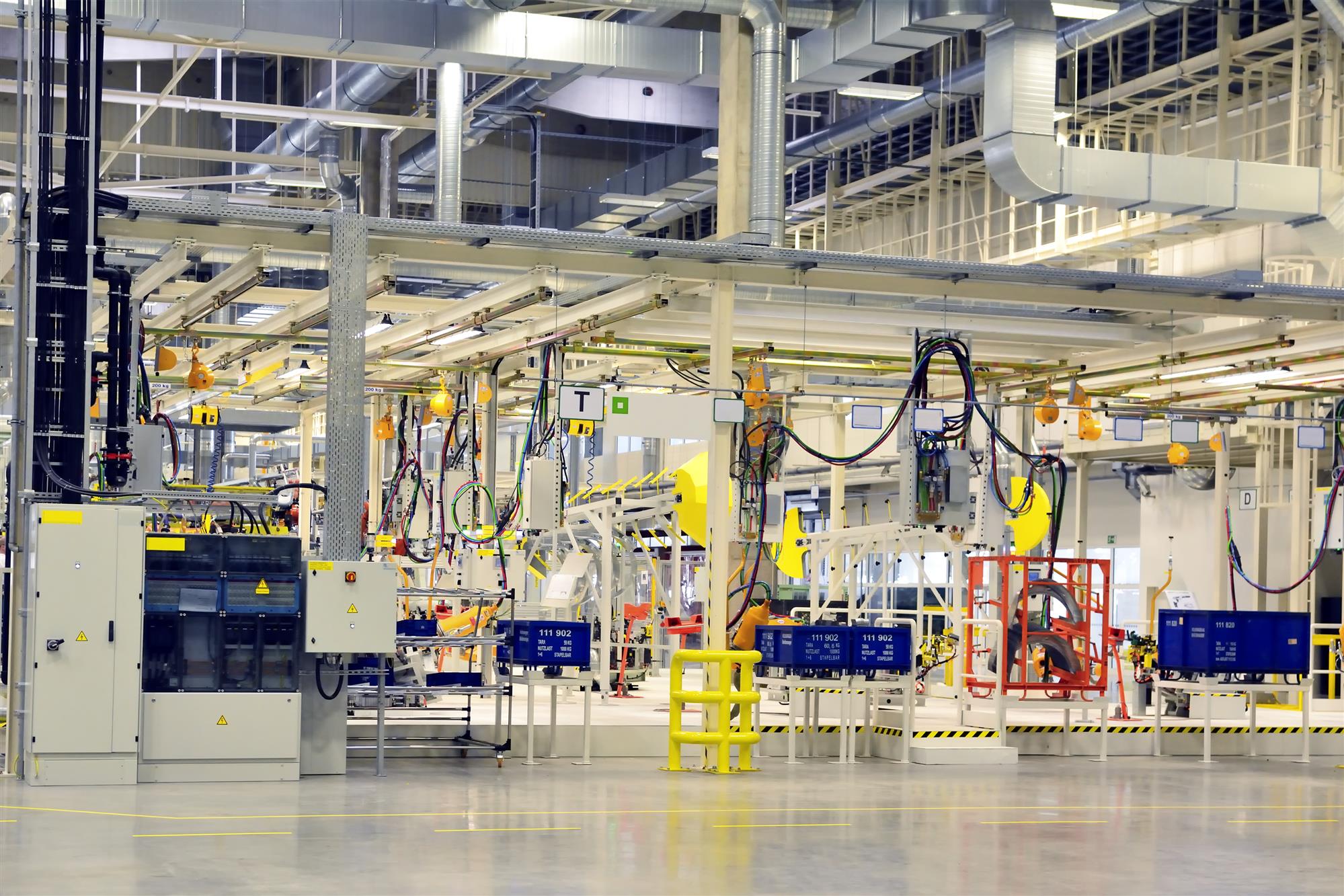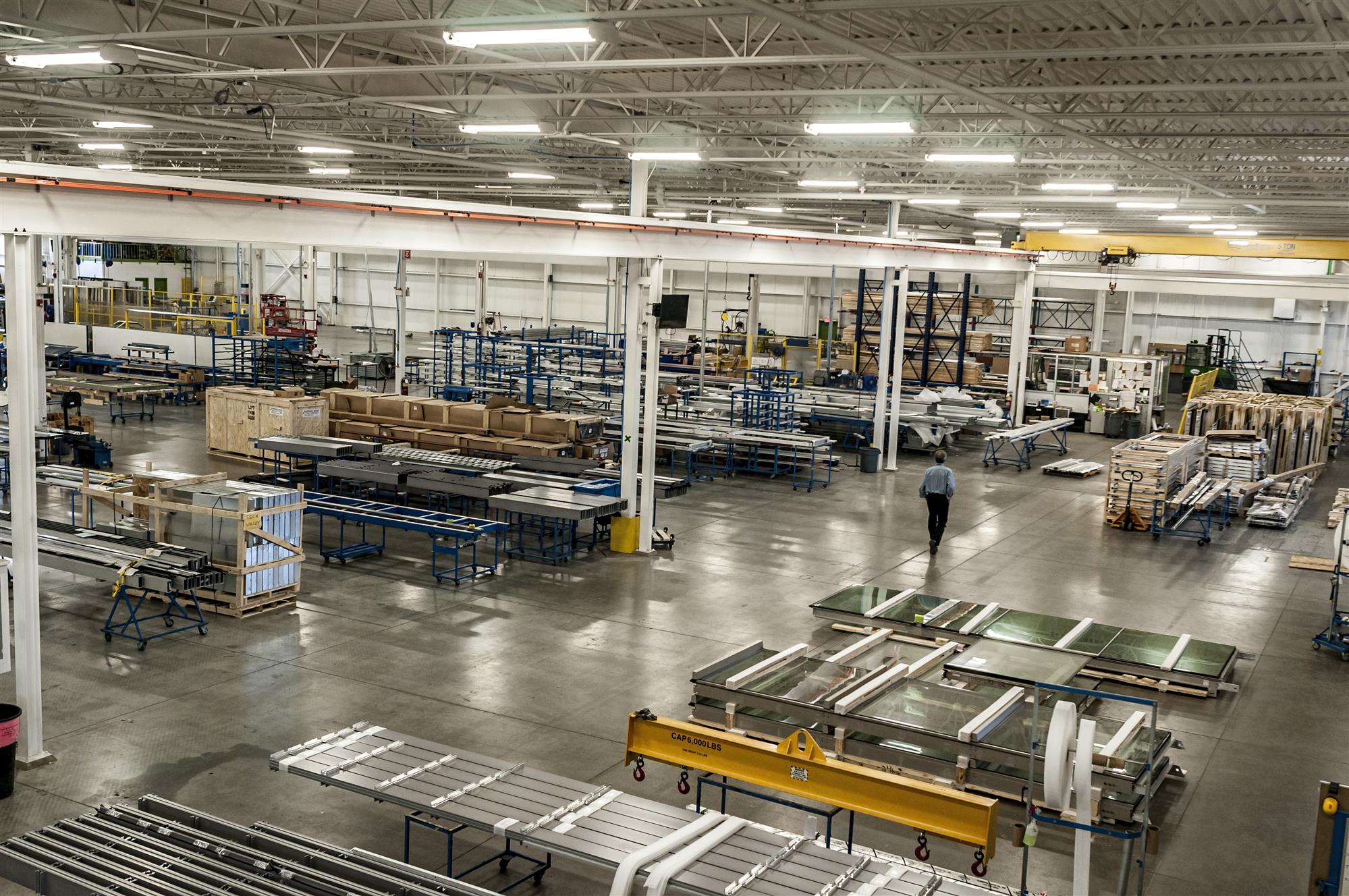Ferrous Cold Saws vs. Non-Ferrous Cold Saws
Learn how to tell the differences between ferrous and non-ferrous cold saws and saw blades by reviewing this blog presented by Quantum Machinery Group.
In the world of metal fabrication, one of the most convenient pieces of equipment is a cold saw—a circular saw that doesn’t create any heat, sparks, or dust. When sheet metal needs to be cut quickly and at a high rate of production, cold saws are especially valuable for their safety and ease of handling.
Cold saws can be made from a variety of metals, some ferrous and some non-ferrous. In this post, we’ll explore the differences between the two types of blades and what kinds of materials are best used with each type.
What’s the Difference?
The terms “ferrous” and “non-ferrous” refer to the iron content in the saw blade. A ferrous saw is one that contains iron, while a non-ferrous saw does not contain iron.
Commonly-used ferrous materials include metals like carbon steel, alloy steel, and (of course) cast or wrought iron. Because of the iron content, ferrous metals are generally vulnerable to rust, with the exception of wrought iron and stainless steel.
Common non-ferrous metals include aluminum, lead, zinc, tin, gold, silver, and copper. Because there is no iron in non-ferrous metals, they are particularly resistant to rust and often used for outdoor objects like signs, gutters, roofing, etc. They are also non-magnetic as a result of their lack of iron, which makes them valuable for various electrical/electronic uses.
Ferrous vs. Non-Ferrous Cold Saws: Uses and Benefits
When it comes to the use of the cold saw, the primary difference between the two blade types is the kinds of metal it can cut. Ferrous cold saws are capable of cutting both ferrous and non-ferrous metals, while non-ferrous saws can only cut non-ferrous metals. Because non-ferrous metal is softer than ferrous metal, non-ferrous blades are typically used for soft metal applications like cutting aluminum.
The benefit of both types of cold saws, of course, is that the cutting can be done without transferring heat energy into the metal, allowing for safer, easier handling. Plus, cold saws don’t create dangerous sparks or a metal burr. Cold saws also create less discoloration on the metal itself. If the saw uses a flood coolant system to cool and lubricate the blade teeth, it may even prevent discoloration entirely.
Get High-Quality Metalworking Equipment from Quantum Machinery Group
With over 150 years of combined experience and more than 760 models of machinery available, Quantum Machinery Group is your source for top-quality metalworking equipment at great prices. Whether you’re looking for a cold saw, band saw, roll bender, or another machine, our expert staff can help you find exactly what you need to get the job done right.
As a leading supplier of metalworking equipment in the United States, Quantum Machinery Group is ready to help your business take its production to the next level. To learn more about our machinery models and convenient financing options, call one of our sales engineers today at (909) 476-8007.
Increase Work Efficiency in Your Company with These Master Tips
Check out these master tips from Quantum Machinery Group on how to increase work efficiency at your metal fabrication, machine shop, or manufacturing business.
Does your company perform like a well-oiled machine? If the answer is occasionally no, you may have changes to make. Work efficiency is a must in the manufacturing industry; each lost second is equivalent to lost money, and each weak link will reduce the efficiency of your overall chain.
From pipe bender machines to the employees who monitor them, every single facet of your machine line matters. These six tips will provide you with the guidance you need to make your manufacturing processes shine.
Continuously Review and Retrain How Employees Work
Mandatory training is one of the most beneficial ways to hone your processes, at least when it comes to manpower on the floor. As most manufacturing jobs can be a bit monotonous, it’s easy for workers to start taking shortcuts or forget simple efficiency and safety protocols. They develop their own methods, some of which may or may not be as efficient as your detailed processes.
To be clear, this isn’t necessarily out of laziness; it’s just natural human nature to give processes your own unique “spin.” Everyone works best in their own way. You should strive to balance the need for time-tested efficient processes while still encouraging creativity and ideas from your employees.
Occasional training serves a double-sided role in that it encourages employees to review what you already know works while also sharing their ideas for evolution with you. If you evaluate and find that an employee-specified approach works better, you can work on adjusting your processes to become safer and more efficient based on this new information.
Use Technology to Your Advantage
If you’re still relying on 20-year-old machinery to help run your floor, you aren’t doing yourself a favor. Older methods were advanced, for their time, but have long since been made obsolete. Some may even be dangerous, especially if and when they’re used by poorly trained employees.
Be sure that you constantly evaluate your equipment and identify where upgrades are possible. Computer-guided die cutters, for example, will provide a much more efficient cutting process than laser cutters guided manually by a human hand.
Likewise, today’s computer assembly robots offer greater precision and speed than their predecessors. If you skip upgrades to save money, you could potentially be costing yourself efficiency in the long run.
Evaluate Your Floor Layout
When was the last time you had a birds-eye view of your floor layout? Are your lines set up in a way that makes the most sense, encouraging work to flow from point A to B in a fluid, efficient manner? If not, it may be time to re-evaluate.
Using an overhead view of your floor plan, look for weak points that shave a couple of seconds off of your efficiency here and there. Potential issues could be as simple as machinery locked behind closed doors unnecessarily or as complex as having the right machines located close to one another rather than at opposite ends of the floor.
Even the location of your washrooms can impact efficiency; the further away they are, the longer employees will take to make it back to the floor each time. There’s plenty of room to enact safe practices when using machines like lasers or band saws while still ensuring that floor staff can use them efficiently.
Reach out to Quantum Machinery Group today for more information about the tips mentioned in this blog or to discuss your needs for upgraded manufacturing equipment to eliminate bottlenecks and boost productivity in your facility.
The Future of Manufacturing in the U.S.A
Quantum Machinery Group shares insights about the future of manufacturing in the United States and why this industry has a positive outlook in the coming years.
The manufacturing industry in the United States is growing by leaps and bounds. As technology changes and allows us to produce items more rapidly, so, too, does the manufacturing industry itself. Comparing today’s industry to the industry of the 1950s demonstrates this clearly; more often than ever, we’re relying on machines like laser cutters and cold saws to help us work with difficult materials.
Although the industry continues to struggle slightly in the face of an uncertain economy, there is hope on the horizon. The future of manufacturing in the U.S.A. is bright; discover why, right here.
A Burgeoning Automotive Industry
Walk through downtown Detroit, and you’ll see the post-bankruptcy effects of a lost automotive industry. The loss of Detroit’s beloved vehicle manufacturing plants hit hard; in fact, it was almost the death of the city altogether.
However, America’s automotive industry is staging a comeback, and it looks like Detroit could very well become part of that comeback, too. Automotive manufacturing lines aren’t decelerating like they were 10 years ago; instead, they’re growing and expanding significantly.
More Manufacturers Staying on Home Soil
Recent assertions by political influencers like Bernie Sanders and Donald Trump have driven home the impacts of companies outsourcing manufacturing jobs to places like China and Mexico. The vast majority of manufacturing companies do this because labor and materials are both far more affordable outside of the country, but a current movement to keep work on home soil via tariffs could change that.
If the POTUS moves forward with his plan, it may become more affordable to open factories here in the United States rather than overseas. This is likely to influence the American manufacturing market significantly, reducing competition for the local market and spurring on job creation, too.
Incentivized Exports
The POTUS and other influencers want to keep manufacturing jobs here on home soil, but that doesn’t mean that you won’t be encouraged and incentivized to work in tandem with other countries.
On the contrary; some people suggest the implementation of a certificate system that would incentivize and encourage exports to other countries. These certificates would effectively come in denominations equal to the value of the export.
Importers would need to purchase these certificates, evening out the trade deficits and creating an environment where the U.S. manufacturing industry is competitive. It would effectively give plants the power to offer lower-cost (and therefore more competitive) products to places like the United Kingdom, Canada, South America, Malaysia, and China.
More Technology in Manufacturing Plants
Despite the fact that more manufacturing will likely occur on home soil, plants are likely to rely on technology more than ever. Cold lasers, pipe benders, and even robotic assembly are all becoming more common, reducing costs in the process and eliminating the need for multiple staff members in the process.
Don’t assume you can rely on machines entirely; nothing could be further from the truth. You’ll still need to hire monitoring and management staff to oversee operations, but the type of employees you hire will shift from blue collar to tech savvy.
For more information about the wide array of innovations in the U.S. manufacturing space, reach out to the team at Quantum Machinery Group today.
Safety Tips for Working with Heavy Machinery
Everyone can benefit from reviewing these safety tips for working with heavy machinery featured in this post presented by Quantum Machinery Group.
Working with heavy machinery is incredibly rewarding, but it does require a healthy dose of safety and caution. Large machines increase the risk of serious injury when safety measures are ignored. Most workers understand basic machine safety tips like “don’t drink and operate heavy machinery,” but it is often far too easy to overlook other more subtle guidelines.
Whether you’re using a band saw or a forklift, we want to help you reduce the risk of accidents with the following important safety tips.
Always Inspect Your Equipment
When was the last time your equipment was fully and properly inspected? For most manufacturing hubs, the answer should be within the last few days. Some machinery may even require daily monitoring for efficiency and safety issues. You should train your workers to briefly inspect any equipment they use for issues prior to beginning their shift; follow this up with a daily, weekly, or monthly full inspection by an experienced repair or maintenance specialist.
Maintain Machines Properly
This tip falls under the previous tip, at least to some degree, but takes the concept just a bit further. Proper maintenance (whether oiling, replacing bearings, or even replacing old equipment completely) is crucial for overall worksite safety. Schedule in maintenance tasks and have at least one person in management oversee them. If they aren’t getting completed in a timely manner, find out why; it takes just one broken blade or bearing to cause a serious or fatal injury on the floor.
Watch for Blind Spots
Whether you’re using a large saw or a forklift, every piece of machinery requires you to work from a certain angle and position. This increases the chance of blind spots that can block your view and increase the danger. Before using machinery, determine where your blind spots are and do your best to keep them in mind at all times.
Have Communication Rules in Place
Nearly as important as proper maintenance is the need to communicate effectively when handling machines. If your floor is excessively loud, consider granting machine operators hands-free CB radios or smartphones for communication. Enact protocols for communication that support everyone knowing where everyone else is on the floor at all times.
For example, if someone is driving a forklift loaded with pallets, everyone around them should know that the forklift is active and driving around the floor. Safety lights, signs, and announcements can all assist you in achieving this goal.
Make Safety Equipment Mandatory
Last, but most certainly not least, is the need to make safety equipment mandatory. Depending on where you operate, this may not just be an optional tip, it could be mandatory, too. Items like protective goggles when using cold laser equipment or hard hats in fall zones keep your employees safe and reduce the incidence of accidents. Slacking off and letting your staff leave their safety equipment off could put their lives at risk.
If an accident happens and the courts can prove you neglected to enforce safety equipment rules, you could even be held responsible for compensation, too. Don’t take this risk; post rules clearly around the floor and enforce them whenever you see slips.
At Quantum Machinery Group, safety is always on our minds. For more information on enacting safety protocols, or to learn how we stress safety on our manufacturing lines, feel free to reach out to us today.
Main Characteristics of Sheetmetal That You Need to Understand
Sheet Metal has its own unique set of characteristics depending on the type of metal, which Quantum Machinery Group discusses in detail this blog post.
When you hear the word “sheetmetal,” you likely picture the type of metal used to make heating and AC ducts. That is a very common use of sheetmetal, but there are many other types of sheetmetal that fabricators may use in a variety of different applications. Whether there will be section bending or welding to create specific functionality, choosing the right type of sheetmetal is important.
Sheetmetal Is Steel
While there are times when sheetmetal is very thin and flexible, it is not an aluminum product; sheetmetal is made from steel. This steel is unpredictable and has a great deal of variability, depending on the yield, impurities, and perfections.
The label A36, for example, has a yield strength of more than 36,000 psi. and a thickness of 0.0075 in. This helps fabricators choose the right sheetmetal for their jobs and to provide strong structures. This is also a drawback because the A36 label means at least 36,000 psi, but a 41,000 psi sheet will also be labeled A36, and the increased strength can lead to remarkable differences.
The more knowledgeable a fabricator is about the characteristics of sheetmetal, the more likely they will produce uniform pieces without a lot of variations and weaknesses.
Measuring and Cutting
Everyone has heard that for precision and to avoid mistakes you should always measure twice and cut once. This is especially true when working with sheetmetal because there is no forecasting software that can predict how sheetmetal will react to various conditions.
Simply put, cutting sheetmetal may lead to a variety of reactions based on temperature, cutting method, and, of course, the steel composition. Taking the time to measure twice and cut once will save materials and working hours.
Math Is a Major Part of Working with Sheetmetal
Not only do you need to know what yield your sheet metal is and the dimensions required for the finished pieces, you also need to know the temperature required for heat cutting and the angles needed for the strongest bends based on the thickness variations. It can be a complex matter to put all of these numbers together to create a functional completed piece.
Working with sheetmetal requires a bit more than a sharp pair of tin snips and pliers. Press-brake operation is a major part of fabrication with sheet metal, whether the end goal is ductwork, car parts, tool boxes or appliances. Data tables and algorithms can only go so far; it requires a metal worker who knows sheetmetal to ensure that the bends and cuts are made in a way that strengthens rather than weakens the piece.
When you’re in the market for sheetmetal tools, a trip to the nearest hardware store won’t meet your needs. Visit Quantum Machinery for all you need to work with metal, from cutting implements to mandrel benders. Whether automation and mass production is your goal or whether you prefer to be involved in every step of the process, there are machines and tools available to help you make the most of every piece of metal.











